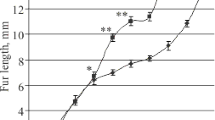Summary
Aminopeptidase activity of three fractions of human erythrocytes (membranes free of hemoglobin; hemolysate free of membranes; enzyme protein fraction made free of hemoglobin by DEAE-cellulose) was measured by a NADH dependent optical test using asparaginyl1-angiotensin II-amide as substrate.
-
1.
From the enzyme protein fraction 6 subfractions were obtained by (NH4)2SO4 precipitation. By measuring enzyme kinetics at three different pH-values (pH 5,0; 7,0; 8,0) with and without addition of the effectors Na2EDTA and Ca++ the existence of 6 different enzymes could be demonstrated.
-
2.
The aminopeptidase activity of the hemolysate made free of membranes could be inhibited by diisopropylfluorphosphate and p-chloromercuribenzoate at three different pH-values (pH 5,0; 6,5; 7,0; 8,0 and 6,5; 7,0; 8,0 respectively).
-
3.
A reduction of enzymatic activity of 20% was found after incubation at 37°C for two hours.
Zusammenfassung
In menschlichen Erythrozytenfraktionen (hämoglobinfreie Erythrozytenmembranen; membranfreies Hämolysat; durch DEAE-Cellulose von Hämoglobin befreite Enzym-Protein-Fraktion) wurde mit Hilfe eines NADH-abhängigen optischen Tests mit Asparaginyl1-Angiotensin II-amid als Substrat die Aminopeptidaseaktivität untersucht.
-
1.
Durch fraktionierte Ammoniumsulfatfällung wurden sechs Unterfraktionen aus der Enzym-Protein-Fraktion gewonnen. Mit Hilfe von enzymkinetischen Untersuchungen bei drei verschiedenen pH-Werten (pH 5,0; 7,0; 8,0) mit und ohne Zusatz von zwei verschiedenen Effektoren (Na2EDTA und Ca++) gelang der Nachweis von sechs verschiedenen Enzymen.
-
2.
Durch die Inhibitoren Diisopropylfluorphosphat und p-Chloromercuribenzoat wurde bei verschiedenen pH-Werten (pH 5,0; 6,5; 7,0; 8,0 bzw. 6,5; 7,0; 8,0) eine signifikante Inaktivierung der Aminopeptidaseaktivität des membranfreien Hämolysats beobachtet.
-
3.
Das Temperaturoptimum für die Aminopeptidaseaktivität des Hämolysats lag bei 47°C. Bei 37°C trat nach einer Inkubation von 2 Stunden ein Aktivitätsverlust von 20% ein.
Similar content being viewed by others
Literatur
BEHAL, F.J., HAMILTON, R.D., KANAVAGE, C.B., KELLY, E.C.: Studies on Aminopeptidase in Human Blood. Arch. Biochim. et Biophys.100 308 (1963)
BROWNLEE, K.A.: Stiatistical Theory and Methodology in Science and Engineering, S. 504. New York: John Wiley and Sons, Inc. 1967
DAHLHEIM, H., PETSCHAUER, K., THURAU, K.: Anreicherung und Charakterisierung der Erythrozytenangiotensinase. Pflügers Arch. ges. Physiol.305 105 (1969)
HENNESSEY, M.A., WALTERSDORPH, A.M., HUNNEKENS, F.M., CABRIO, B.W.: Erythrocyte Metabolism. VI. Separation of Erythrocyte Enzymes from Hemoglobin. J. clin. Invest.41 1257 (1962)
HICKLER, R.D., LAULER, D.P., THORN, G.W.: Plasmaangiotensinase-Activity in Patients with Hypertension and Edema. J. clin. Invest.42 635 (1963)
ITSKOWITZ, H.D., MILLER, L.D.: Differential Studies of Angiotensinase Activity from Several Tissue Sources. Amer. J. med. Sci.254 659 (1969)
KHAIRALLA, P.A., BUMPUS, F.M., PAGE, J.H., SMEBY, R.R.: Angiotensinase with a high degree of Specifity in Plasma and Red Blood Cells. Science140 672 (1963)
KLAUS, D., KAFFARNIK, H., PFEIL, H.: Untersuchungen über die Serum-Angiotensinase. I. Mitteilung. Klin. Wschr.41 376 (1963)
KLAUS, D., KAFFARNIK, H., PFEIL, H.: Untersuchungen über die Serum-Angiotensinase. II. Mitteilung. Klin. Wschr.41 379 (1963)
KOKUBU, T., AKKUTSU, H., FUJIMOTO, S., UEDA, E., HIWADA, H., YAMAMURA, Y.: Purification and Properties of Endopeptidase from Rabbit Red Cells and Process of Degeneration on Angiotensin. Biochim. biophys. Acta191 668 (1969)
KOKUBU, T., UEDA, E., FUJIMOTO, S., HIWADA, K., SANGA, H., YAMAMURA, Y.: Angiotensinase in Red Cells. Clin. Chim. Acta13 13 (1966)
MATSUNAGA, M., MASSON, C.M.C.: Hepatic and Renal Angiotensinases. Experientia26 1297 (1970)
NAGATSU, J., GILLESPIE, L., FOLK, J.E., GLENNER, G.G.: Serum Aminopeptidase "Angiotensinase" and Hypertension - I. Biochem. Pharmacol.14 721 (1965)
NAST, H.P., DISTLER, A., SCHREIBER, G., WALTER, U.: Inaktivierung von α-L-Asparaginyl1-Angiotensin II durch Erythrozyten bei Gesunden, bei verschiedenen Hochdruckformen und bei Lebererkrankungen. Z. klin. Chem.5 210 (1974)
OELKERS, W., GOLDACKER, I.U. v.: Bestimmung der Angiotensinase-(Aminopeptidase)-Aktivität im Serum mit einem DPN.H-abhängigen optischen Test. Klin. Wschr.45 649 (1967)
PAGE, I.H., BUMPUS, F.M.: Angiotensin. Physiol. Rev.41 331 (1961)
REGOLY, D., RINIKER, B., BRUNNER, H.: The enzymatic degradation of various angiotensin II derivates by serum, plasma, kidney homogenate. Biochem. Pharmacol.12 637 (1963)
RINIKER, B.: Recent work on the chemistry and biochemistry of angiotensin II. Metabolism13 1247 (1964)
ZWANZIG, M., OELKERS, W.: Untersuchungen über die pH-Abhängigkeit, die Hemmbarkeit und Reaktivierbarkeit von Angiotensin II-amid-spaltenden Enzymen des menschlichen Plasmas. Z. klin. Chem.7 253 (1969)
Author information
Authors and Affiliations
Rights and permissions
About this article
Cite this article
Nast, H.P., Distler, A., Müller, D. et al. Untersuchungen über die pH-Abhängigkeit, Hemmbarkeit und Reaktivierbarkeit von Angiotensin II-amid-spaltenden Aminopeptidasen menschlicher Erythrozyten. Res. Exp. Med. 168, 89–100 (1976). https://doi.org/10.1007/BF01851898
Received:
Issue Date:
DOI: https://doi.org/10.1007/BF01851898




